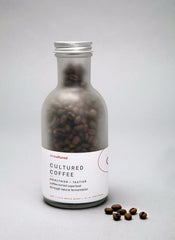How to Brew Great Coffee: The Basics
If you're looking to make a great cup of coffee, learning how to brew it is as important as investing in great beans. Here are our barista-approved basics for making a great of coffee, every time!
Brew Chart
We developed this chart for use with Cultured Coffee, which has a medium or city roast profile. The unique fermentation produces a refreshing and nuanced cup, so our brewing times are designed to reflect that.

While the chart above can help, it's always good to know the basics too. There are a lot of variables to choose from, however here are some general rules of thumb:
Pick Your Beans
Aside from natural flavor differences inherent to different coffee varieties and conditions on the farm, how your beans are roasted and processed will also determine the strength and flavor of the coffee you brew.
Volatile flavor and aroma compounds in coffee beans start to evaporate as you roast. For this reason, dark or espresso roasts are typically more bitter and one-dimensional than light roasts. Lighter roasts preserve the most volatile flavor compounds but may lack the bitter "punch" some coffee drinkers prefer.
Whatever your preference, changing brew methods won't alter the range of flavors you can get from your beans. That's why it's important to pick beans based on your flavor preferences before you consider brew method.
Quantity
Coffee enthusiasts and professionals will gauge the right quantity of coffee according to the "Golden Cup" Standard. This is approximately 11.5 to 13.5 grams of dissolved coffee solids per liter, at which point the concentration of coffee tastes just right!
This quantity equates to roughly 55g of coffee grinds per liter of water (or one to two tablespoons of grounds for every six ounces of water). However, as per our chart above, the exact quantity of grounds to water will vary significantly based on the beans and brew method.
Grind Size
Your preferred brew method will determine how finely or coarsely to grind your coffee beans. Choosing the wrong grind for your brewing method can result in coffee that's too weak, acidic or lacks a full flavor profile. Coffee that's too bitter may be a sign you're grinding too finely for your brew method. A weak brew may be a sign your beans are ground too coarsely.
As a rule of thumb, if water only comes into contact with ground coffee for a short amount of time (espresso machines, Turkish, Aeropress) you'll need a finer grind to maximize the surface area of the bean exposed to water.
If coffee grounds are steeping, as in French Press or Chemex style coffee, you'll need coarser grinds to avoid brewing coffee that lacks depth of flavor.
Using a good grinder is key to getting a consistent grind size and flavor. Coffee grounds that are uniform and the right consistency for your brew style mean just the right amount of coffee is exposed to water as it steeps.
Burr grinders, while more expensive, typically yield the most even grind results and therefore flavor. Regular grinders with rotating blades are a more affordable option, though less likely to achieve a consistent grind and flavor.
Brew Time
The Speciality Coffee Association recommends a brew time of four minutes for styles using fine grounds up to eight minutes for coarser grinds. Combination brewing methods like the Aeropress or espresso machines significantly reduce brew time due to the finer grind size and extraction process.
Stirring the coffee also helps to evenly disperse flavor more rapidly in the brew for French press styles, however doesn't negate the need for steeping grinds.
Water
The temperature of the water used to make your coffee will impact the taste.
To achieve the "Golden Cup Standard," the water you use in your brew should be around 200°F ± 5° (93.0°C ± 3°). This is the point at which the flavor and aroma compounds in the grounds will best dissolve into the water (and evaporate into the air for that signature aroma).
While still a source of debate, the water you use may affect the flavor of your coffee. In fact, the Speciality Coffee Association even designates different grades of water based on odor, pH and how the water looks. The ideal water is clean, clear and odor free to avoid masking flavors in your beans. Using a water filter may help remove traces of minerals or chemicals.
Filters
If your brew method entails pouring water through a machine or funnel, the odds are you'll need a filter to trap the grounds. Filters can come in a range of sizes and varieties.
Paper filters can be bleached using chlorination or oxygen to achieve a consistent texture, look and prevent the filter from imparting any flavor to the coffee as it passes through it. Unbleached filters made from recycled wood fiber also do the same job without prior bleaching. Non-bleached filters should have water poured through them first and the water discarded before use to avoid adding a paper taste to the coffee.
Alternatively some chemex and drip brewers use a rinsable fine metal mesh to replace the need for added filters altogether.
We hope this short guide helps you achieve a consistent and tasty cup every time. Enjoy!
Learn more about eatCultured's first healthy fermented product: Cultured Coffee


Leave a comment
Please note, comments must be approved before they are published